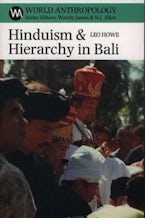
Title Details
256 Pages
23.4 x 15.6 cm
17 b/w, 5 line illus.
Series: World Anthropology
Imprint: James Currey
Hinduism and Hierarchy in Bali
- Description
- Reviews
The book looks at how conflict and competition between various forms of Hinduism undermines and sustains relations of hierarchy.
In the context of Dutch colonialism, world war, the incorporation of Bali into the Indonesian state and the tourist boom, this book examines the complex relationships between the changing nature and continuing relevance of Balinese hierarchy, the neo-Hindu reforms of Balinese religion, and the impact these have had on new forms of identity.
Since at least the 1920s commoners and other intellectuals and reformers have sought ways to challenge Balinesecaste hierarchy, both through egalitarian re-interpretations of Balinese institutions and through changing religious ideas and practices. State initiatives to transform 'traditional' Balinese religion into monotheistic and more 'authentic' form of Hinduism have precipitated the appearance of many indigenous new religious movements and the importation from India of devotional forms of Hinduism (Sai Baba and Hare Krishna), which has created a vastly more intricate religious landscape. These various forms of Hinduism, and the conflict and competition between, both undermine and sustain relations of hierarchy.
Through historically informed, ethnographic analyses of status competition, caste conflict, ritual inflation, religious innovation, and the cultural politics of identity this book, written in an accessible style, makes a major contribution to our understanding of modern Balinese society and its future development.
Series editors: Wendy James & N.J. Allen
In the context of Dutch colonialism, world war, the incorporation of Bali into the Indonesian state and the tourist boom, this book examines the complex relationships between the changing nature and continuing relevance of Balinese hierarchy, the neo-Hindu reforms of Balinese religion, and the impact these have had on new forms of identity.
Since at least the 1920s commoners and other intellectuals and reformers have sought ways to challenge Balinesecaste hierarchy, both through egalitarian re-interpretations of Balinese institutions and through changing religious ideas and practices. State initiatives to transform 'traditional' Balinese religion into monotheistic and more 'authentic' form of Hinduism have precipitated the appearance of many indigenous new religious movements and the importation from India of devotional forms of Hinduism (Sai Baba and Hare Krishna), which has created a vastly more intricate religious landscape. These various forms of Hinduism, and the conflict and competition between, both undermine and sustain relations of hierarchy.
Through historically informed, ethnographic analyses of status competition, caste conflict, ritual inflation, religious innovation, and the cultural politics of identity this book, written in an accessible style, makes a major contribution to our understanding of modern Balinese society and its future development.
Series editors: Wendy James & N.J. Allen
"This is an important book with a clear (and classic) theme. It describes extremely well the different forms of Hinduism in Bali, and the connections and tensions between them... likely to be seen as a landmark in anthropological studies of Bali... -" David Gellner, Brunel University
Paperback
9780852559192
February 2002
$36.95 / £24.99
Title Details
256 Pages
2.34 x 1.56 cm
17 b/w, 5 line illus.
Series: World Anthropology
Imprint: James Currey








